Michael Laub / Remote Control Productions
The H.C.Andersen Project
– Tales and Costumes (2003)
PHOTOGRAPHY / CREDITS / PRESS
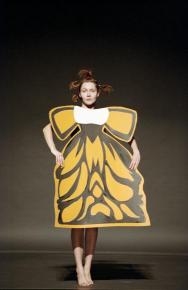
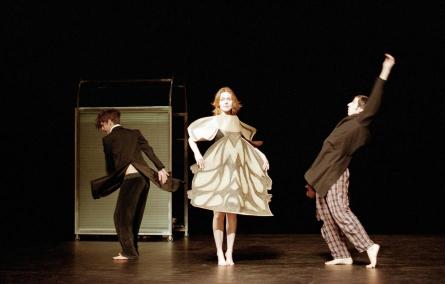
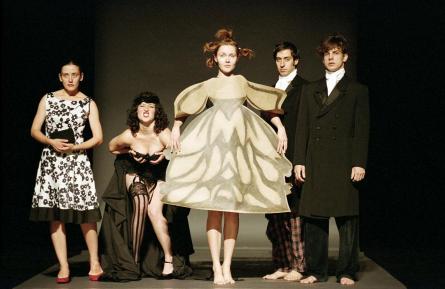
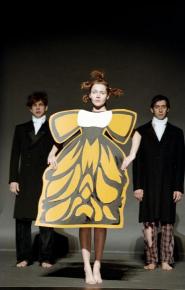
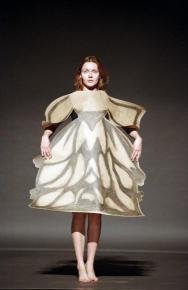
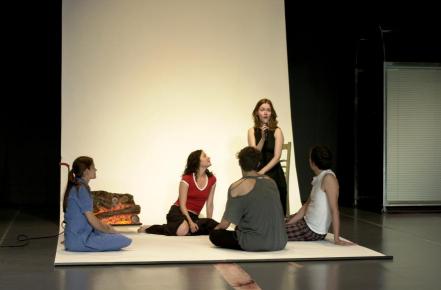
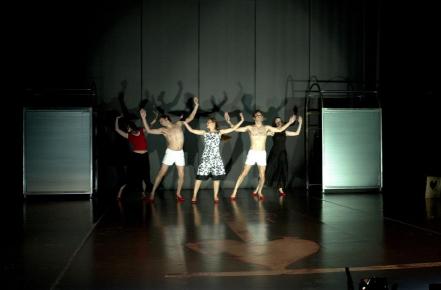
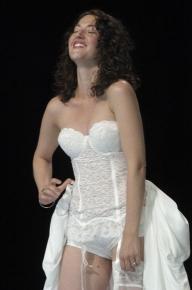
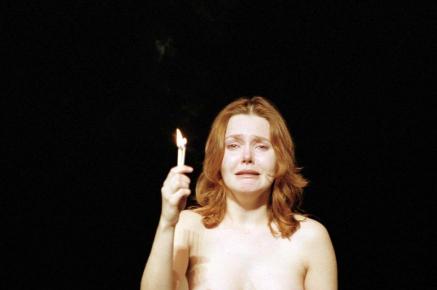
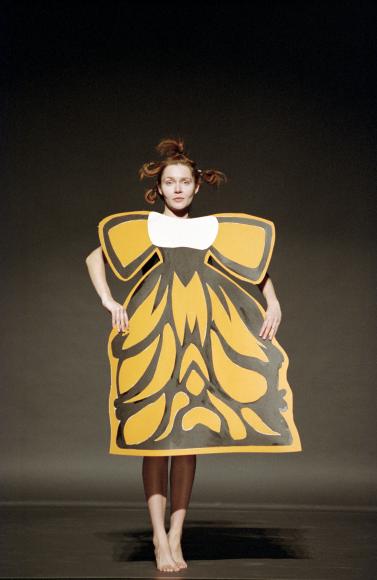
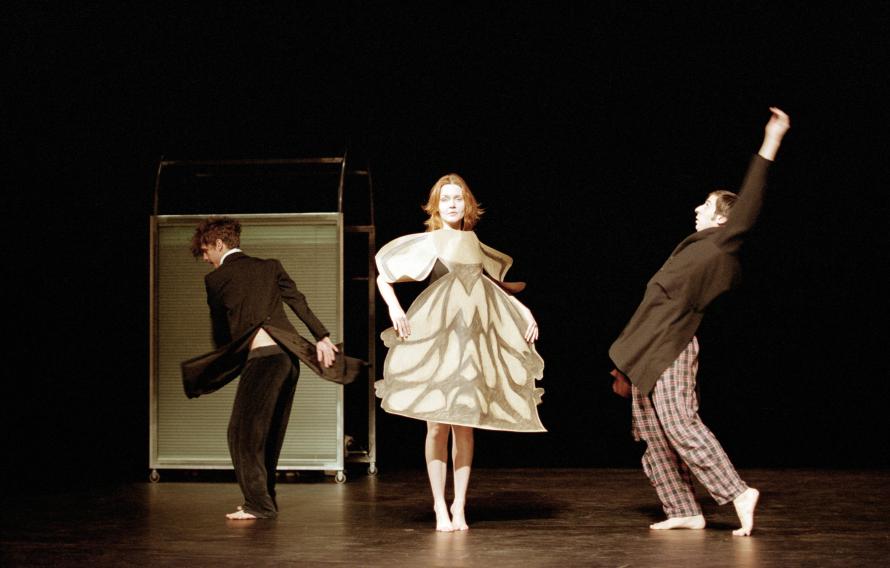
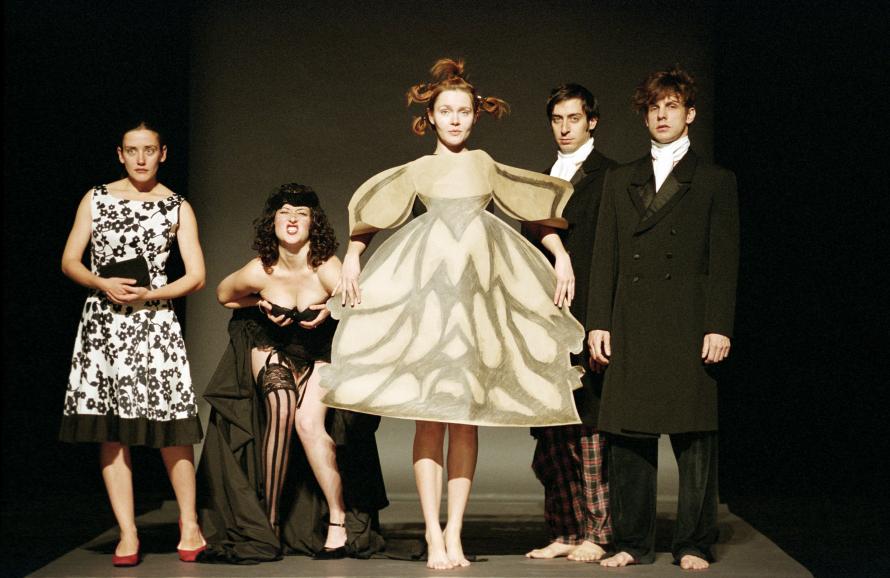
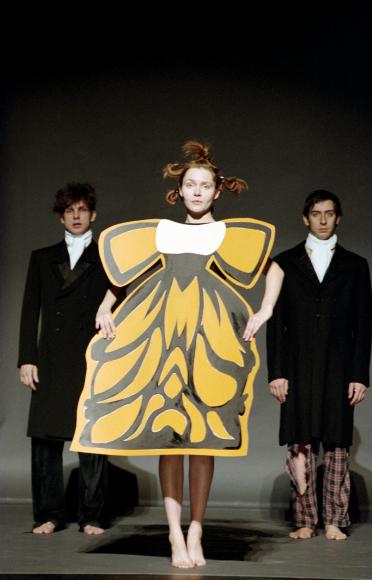
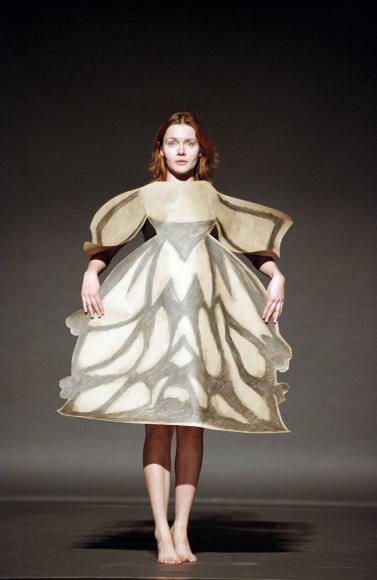
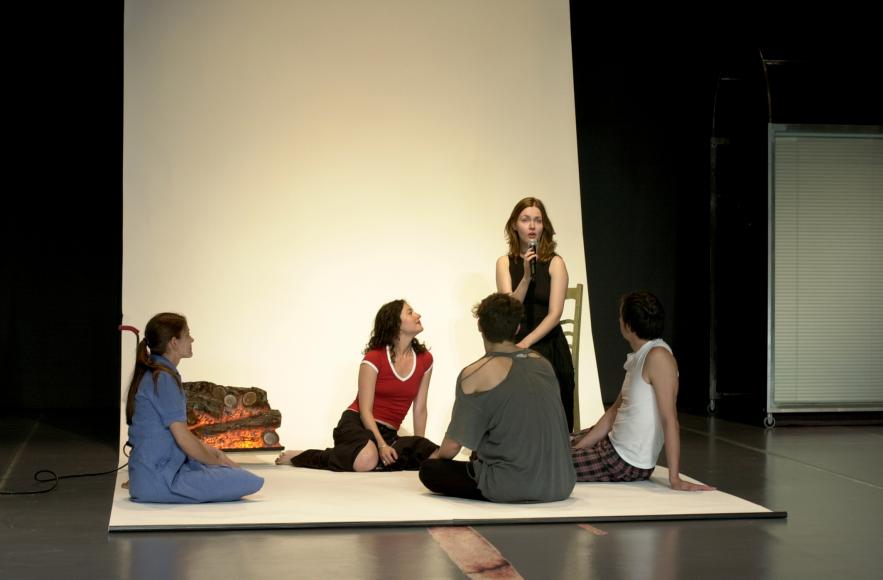
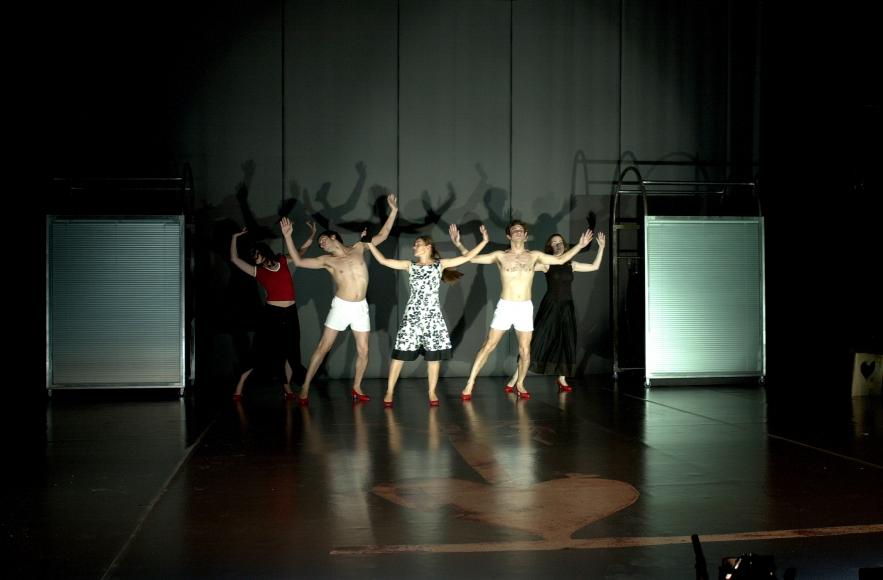
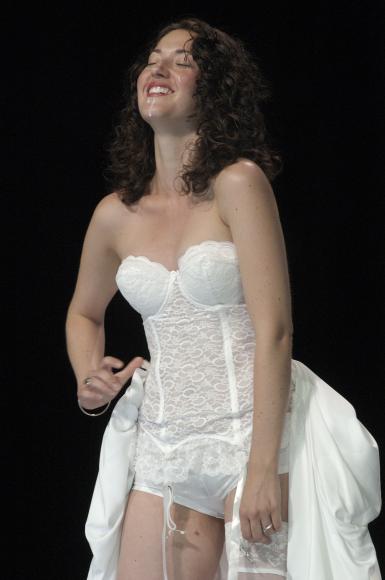
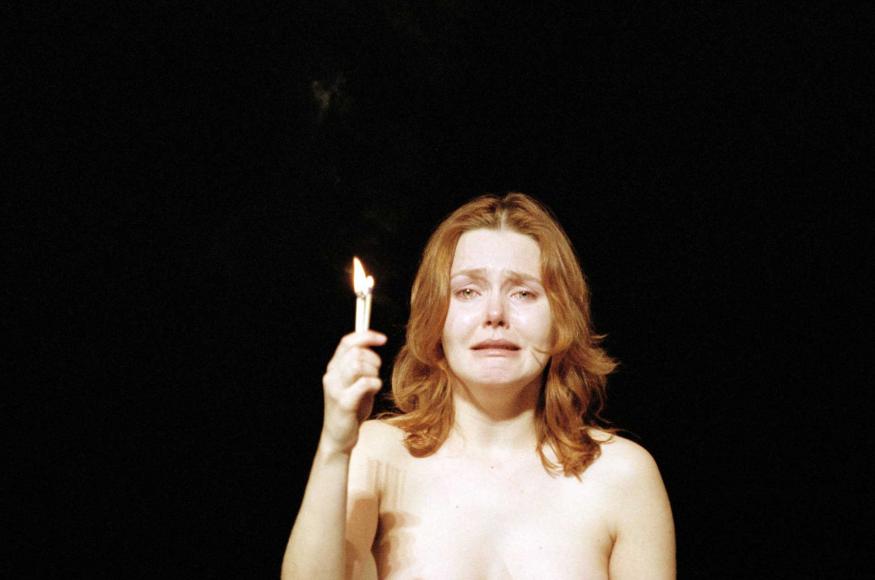
"H.C.Andersen leaves Odense, his hometown at the age of 14 to go to Copenhagen and become a ballet dancer and an actor. He enters through the city gate and the first thing he wants to do is to go to the Royal Theater, but it is closed because it’s Monday. Then he remembers hearing about the famous ballerina Mme Schall. So he goes to her house where she is having a dinner party entertaining guests. He insists they see him dance so they let him in. He takes his shoes off and starts dancing with his long limbs and big feet pretending his hat is a tambourine. They laugh at him and throw him out."
(Hildigunn Eydfinsdottir)
"Friday, June 4th 1875 (…) At home a visit from the sculptor Saabye, to whom I said loud and clear that I was dissatisfied with his statue of mine, that neither he nor any of the sculptors knew me, that they hadn’t seen me read, that I didn’t tolerate anyone standing behind me and never had children on my back, on my lap or between my legs, that my tales were just as much for older people as for children, who only understood the outer trappings and did not comprehend and take the whole work until they were mature – that naiveté was only a part of my tales, that humor was really what gave them their flavor."
(H.C.Andersen)
"The first time I heard about H.C.Andersen was in a diner in Southern California in one of these small towns where you stop on the way to a bigger town. My parents took me to a restaurant called Pea Soup Andersen’s where they had this room in the basement full of dioramas of H.C.Andersen stories. My favorites were The Little Match Girl, The Emperor’s New Clothes and The Princess and the Pea."
(Levi Gonzalez)
CREDITS
Director Michael Laub
Choreography Greg Zuccolo, Michael Laub and the Company
Music Larry Steinbachek
Light-Design Nigel Edwards
Sound Jean-Pierre Urbano
Set-Design Norbert Stück
Costumes Miro Paternostro and the Company
Text Hans Christian Andersen, Michael Laub and the Company
Technical Director Jochen Massar
Subtitles Marold Langer Philippsen
Assistant Director Claudine Profitlich
Production-Management Elisabeth Knauf, Claudine Profitlich
Performers Astrid Endruweit, Hildigunn Eydfinsdottir, Levi Gonzalez, Stephanie Weyman, Greg Zuccolo
Co-Production Hebbel-Theater, Berlin, Zuercher Theater Spektakel, Szene Salzburg, Remote Control Productions in collaboration with Marina Abramovic, with support from Raz, Hans Tuerlings
Paper-cuttings by Hans Christian Andersen used by permission from Odense City Museums, Denmark
With many thanks to Big Image Systems, Germany.
PRESS
Les Inrockuptibles, 11 – 17 May 2005: Fabienne Arvers
Once Upon A Time
The honour of opening the Rencontres choréographiques internationales de Seine-Saint-Denis went to Andersen, along with Michael Laub, under the sign of artistic and political engagement.
Apart from cultivating a look tinged with hell, a loose tongue, and humour to take your breath away, polishing with equal ardour the living bones of irony and tenderness, Michael Laub has for thirty years been navigating through the troubled and rejuvenating waters of that which not long ago used to be termed – by incorrigible dreamers – alternative culture.
A past master in the staging and performance of “cut-up” and collage, someone who unites music, dance, theatre and video, this Belgian who ran aground in Stockholm for more than 10
years – “my masochistic period,” he says with relish today – and is now based in Amsterdam but produces more work in Germany, has always kept close to Performance artists, visual artists, video filmmakers and musicians, dancers and comedians. Notably the artist Marina Abramovic, the Belgrade-born Performance artist, who will present at the next Avignon Festival her “Biography Remix” under Laub’s direction, or the composer Larry Steinbachek, who is responsible for the music in The H. C. Andersen Project, which was presented at the opening of the Rencontres choréographiques internationales de Seine-Saint-Denis.
A dreamlike vision – if a trip, including the hallucinations, can be considered to pass for a dream – of the life and work of Andersen. A kind of “Sentimental Education” of a man famed for his children’s tales although he dreamed of being a dancer, suffered from hypochondria, frequented brothels in the role of voyeur. In short, not really a tale of fairies one would care to meet after reading, before going to sleep, “The Snow Queen”, “The Princess and The Pea”, or “The Ugly Duckling”.
In fact, it was during improvisations on childhood and lost innocence for a show about Genet that the opening scene of The H. C. Andersen Projec” was born: radiant and scintillating in her pink dress, Hildigunn Eydfinsdottir, a Scandinavian from the Faeroe Islands, has a particular talent for weeping. She talks about her first kiss, sheds the dress, stands naked with a box of matches in her hand and weeps while relating the tale of “The Little Matchseller”.
It would be difficult to enact more simply, to blend more intimately, the cruel narrative of Andersen and the sensibility of his interpreter, her simple and profound adhesion to the atmosphere of those tales made to endure the hardship of life as much as that of humankind, just as one relishes a shooting pain for lack of being able to forget it. The rest of the show is in keeping: short sequences for the narratives crossed with the disappointments suffered by Andersen and those suffered by the performers – without forgetting the tales – distilled with fragments, scraps of memory, kind of obsessive accents subjected to interruption, often by the danced intercession of Greg Zuccolo and Levi Gonzalez. Three girls stand up to them: as well as the already mentioned blonde and beautiful Hildigunn Eydfinsdottir, one relishes the priceless gait of Stephanie Weyman and the magnetism of Astrid Endruweit, droll and bewitching, telling us of her childhood in former East Germany with the aid of dresses and shorts that are wickedly trendy in their own particular genre...
It was high time that France discovered this major artist, who set the pitich of this festival opening centred on performance, recital, humour, the questioning of the interpreter, living material and work in progress.
Liberation, 18 May 2005, Marie Christine Vernay
Dance. Les Recontres choréographiques opened with Hans-Christian Andersen
Tales and Fables in Seine-Saint-Denis
There are those who place their stakes solely on the one-way route of globalization and its derivatives. Others continue to hear individual messages. The latter is true in the case of Anita Mathieu, director of the Recontres choréographiques internationales de Seine-Saint-Denis. From Germany to Chad, taking in Belgium en route, she constructs her festival with young authors, paying no regard to whether they be famous or otherwise, interested only in the quality or the “truth” of their propositions. Six theatres in the region are playing host to the festival for almost a month. A good opportunity for everybody interested in dance to discover artistic presentations which overturn the demands of convention.
The opening of the performance at the Maison de la culture de Bobigny is in the likeness of the festival. Michael Laub, director and choreographer, one of the godfathers of anti-illusionist theatre in the Netherlands, offers his own reading of the Hans Christian Andersen fairytales which lulled into sleep scores of children. Laub was inspired by the distorted image of the Danish writer propagated by Hollywood, but equally by his writings and his life. The author of “The Little Mermaid” and the “Little Matchseller” appears in a new – salacious and cosmogonic – light.
The portrait of the writer who loved the art of dance is painted in hyper-realistic colours. Sifted through a psychoanalytical sieve, it is more raw than authentic. Michael Laub, who founded his company Remote Control Productions in 1981, counts on his performers to put into relief the personages, dancers, actors, narrators or singers. The sublime prostitutes, the prostrate young maidens, the cast of the fairytales blend together to form a single, and nightmarish, waking dream.
(...)
Paul Ben-Itzak, The Dance Insider, 2005
BOBIGNY, France -- With "The H.C. Andersen Project -- Tales and Costumes," which opened the Rencontres Choregraphiques Internationales de Seine-Saint-Denis Friday at MC93, director/conceiver Michael Laub, choreographer-in-chief Greg Zuccolo and crew have delivered a stunning tribute to the greatest story-teller of the modern age, in one of the most effective uses of dance and text in years. But that's not all. Aided by a multi-talented cast and a deft team of designers and composers, more than simply tell some of the stories of Hans Christian Andersen and some of Andersen's own personal story, they have tapped into the story-telling genie and created a paean to its eternal role in our lives.
Not to go 'me' on you again, but as a baby-sitter, my stories for my charges often were dual-purpose: getting them to go to sleep and mitigating my own real-life traumas by working them out in parables that somehow elevated them to the level of the universal. This is just one template Andersen set. "'The Ugly Duckling' is Hans Christian Andersen," Kristian Jensen, curator of a new bicentennial Andersen exhibition at the British Library told the Guardian recently , "and he is also 'The Little Mermaid.' That's how he saw himself, as an oddity, an outsider -- and he was."
With their own dual aim of revisiting some of Andersen's tales and visiting with their creator, Laub & Co. intersperse highlights from the stories with excerpts from Andersen's autobiographies, often dark windows into a bittersweet life with its own good fairies and relentless demons; at one point he ruminates on deteriorating testicles. The best story-tellers -- like the best actors and dancers -- draw on their own vulnerability to relate to their audience. Laub isn't content to simply profit from Andersen's labor or his vivid accounts of his own life. The actor-dancers themselves recount real stories from their lives. (They also contributed to the choreography.) The sometimes underplayed delivery and intimate nature of the recollections make it easy for these interludes to be mistaken, at first glance, as just more post-modern masturbation, but on reflection, the memories shared are often embarrassing and therefore risky.
Levi Gonzalez emerges in a pair of white-striped blue track pants and explains that he didn't wash them for five years, because he wasn't sure they could be washed. When a lover peed on them in bed, he relates, he had no choice, and discovered they could survive laundering. Zuccolo (a Tere O'Connor regular) recounts a Chinese double who would emerge from his 13-year-old self whenever he masturbated and who, after being jerked-off by Zuccolo, would be absorbed again. Astrid Endruweit tells us "These are the (red) gym shorts I wore when I was 13" which, mysteriously, fit her again as an adult. Then she takes us back to gym class, executing a series of tumbles, runs, cartwheels, push-ups and other moves which evoke the P.E. drill but are retarded (in the movement sense) and off-kilter. Endruweit plays on her petite stature and a certain naive quality again later, when she's the daisy in the story of the daisy and the bird. "This is my stem," she announces to us, indicating her green pants, "and these are my petals," rolling her eyes upward at a fake flower beret. She sings "Trah lah lah," about how happy she is, and how the bird makes her happy and she him, until some wicked boys capture the bird and then uproot her and put her in the cage with him to make it seem more like home, but they both die of thirst. Then to punctuate the tragedy and pluck us from it, Zuccolo, who's been implacably perched on an upstage bench, swivels his head to us and belts (to the tune of "She's a Lady") "She's a daisy, whoa-whoa-whoa she's a daisy!"
That line probably came out of a rehearsal inspiration, but others, while seemingly tossed off, later seem to have a direct line to the story-telling theme. In between re-tellings of the Andersen tales, a chorus line of Zuccolo, Gonzalez, and Stephanie Weyman (another American) pop-up, Laugh-In -like, to banter in between boogeying about their first encounters with Andersen in the American pop-culture landscape. One of the men explains how "The Princess & the Pea" was made into the Broadway musical "Once Upon a Matress," and another recalls a Carol Burnett version. "I love Carol Burnett," beams Weyman, whereupon Gonzalez does a take and pivots his head to her with an air of surprise. "I love Carol Burnett." The pattern is repeated later when, after Zuccolo reports that Andersen loved Jesus, Gonzalez now turns to him to insist, "I love Jesus." Perhaps you had to be there to appreciate the humor, but the resonance goes beyond the immediately droll: Burnett in her sketches, like the Bible, told stories and thus they, like Andersen, are part of the never-ending story -- as are these interpreters.
Burnett and her cast also were unafraid to make fools of themselves, and let's get back to that vulnerability. After Zuccolo and Gonzalez, clad in torn pants and shirts, give a brief dance prologue, stomping intently with bent knees and elbows to Larry Steinbachek's rocking score, "The H.C. Andersen Project" opens properly with what the US-based Joyce Theater might call an 'un-family friendly' moment, Hildigunn Eydfinsdottir taking off all her clothes to tell the story of the little Matchgirl. Whether due to latent American prudeness or fatigue with indiscriminate use of nudity in European dance, I cringed at first, a response amplified when Eydfinsdottir started sobbing from the get. It was too easy and left no room for build as, shivering, she descended towards the tragic ending. But thinking back now, I see that, about to expose his subject -- Andersen -- Laub was in a way levelling the field by making his first performer naked.
"The H.C. Andersen Project" is full of moments like this, simultaneously narrating the story at hand, exposing the story-teller (whether the performer of the moment or the original author), and revealing and reveling in the art and act of story-telling. As for the work's craft, it's a perfect synthesis of brazen, communicative, full-frontal post-1990 American dancemaking (acting as a sort of chorus or 'wash' between the stories, as my dancer companion nicely put it) and engrossing European theater (augmented by Nigel Edwards's lighting). After touring the rest of the world for two years, it's time this work was seen in the US as well.
The Rencontres Choregraphiques Internationales de Seine-Saint-Denis continues tomorrow in Montreuil at the Centre Dramatique National, where there's more story-telling afoot, with Daniele Desnoyers, Lia Rodrigues and Boyzie Cekwana taking on the fabled Fables of la Fontaine.
Katrin Bettina Müller, die Tageszeitung, 23.08.2003
The Sensual Language of Dancers
Enticing the unpredictable over and over again: the productions of director and choreographer Michael Laub move between trash, Hollywood and Bollywood on the one hand, and classical highbrow culture on the other. A portrait.
Hybrid forms are booming: in pop music, in literature, in film. Theatre, by contrast, took longer than the other arts to discover the potential of multi-lingualism and differences in origin. Michael Laub is a pioneer of diversity in the theatre. Over the years, the words “In German, English, Danish and Faroese” have repeatedly been printed below the titles of his pieces. Ever since five Lulus – a black woman and two white women from the USA, a Malaysian, and a woman from the Faroe Islands – contributed their own histories, myths and dances to their rendering of the figure Lulu in “Planet Lulu” (1997), foreign elements have glinted through Laub’s productions.
“We live in post-exotic times,” asserts Michael Laub, “and today we travel as easily to the Far East as we once did to Spain.” All the same, diversity is not an attitude he adopts just because it is hip and politically correct. He is primarily interested in his performers not as representatives of a culture, but as individuals. “The individuals are the most exciting and the most unpredictable element.” And the unpredictable, that which can happen only with one specific individual, with the thoughts in his mind and the recollections in his body, is precisely what Michael Laub is always trying to inveigle. His chosen route is that of improvisation: He lurks in wait of the uncontrollable occurring by chance or accident. For instance, he relates how the motif of “The H. C. Andersen Project”, his latest production which premiered in Zurich and is guesting at the Tanz im August festival in Berlin, emerged during rehearsals for a piece devoted to the writings of Jean Genet. During an improvsation about childhood and perverted innocence, the actress Hildigunn Eydfinsdottir talked about her favourite dress, the one she was wearing when she received her first kiss. Laub asked her to take off the dress, knowing – they have worked together for a long time– that she would begin to cry. He handed her a box of matches, just like that, “And she, a Scandinavian who is very aware of her cultural heritage, then recited, naked and weeping, the tale of The Little Matchseller.”
Voilà. It’s as simple as that. Or not so simple, of course, for the subjects and genres cited by Laub on the stage – fairytales in this case, horror films in “Frankula”, or Bollywood in “Total Masala Slammer/Heartbreak No. 5” – always serve as a pretext in order to talk about present-day life, and about the matrix that determines our perceptions and feelings. Laub therefore began investigating Andersen’s life in order to find about this man who in his tales “knew no middle-ground between the depths of despair and the raptures of euphoria.” He discovered a writer who was unhappy about being recognized only as a children’s writer, who loved ballerinas and the ballet, but not his own overlong legs and overlarge feet, who wanted to be at home in sophisticated circles but always felt like an outsider. “We all feel gauche and clumsy. The clumsiest thing of all is to want to be normal, and Andersen wanted that with all his being. He tried to perform normalcy, to act as the artist-about-town, and that almost drove him mad.”
The longer Laub talks about Andersen, the more clear becomes the attraction Andersen’s weaknesses exercise upon him. He starts to list the parallels between the writer and himself, only to dismiss them the next moment.
Michael Laub, who comes from Belgium, lived in Scandinavia for ten years. He finds the French language, which is part of his background, too ornamental to work with. He needs the directness of the Anglo-American for his pieces, he says. That is surely something to do with his personal form of perception that is highly attuned to rhythm.
“I like the way dancers speak,” says Laub, for example. “At the age of five, dancers must begin looking after their bodies, they have to live a very different life from actors, they have other physical needs.” This awareness of the way a chosen art form changes one’s life is a distinctive feature of Laub’s work. Like the planets of a cosmic system, dance and speech, body and text orbit around each other in the performances of his Remote Control Productions. Language is imbued with a sensuality otherwise seldom encountered in the theatre.
Compared with the two projects Laub completed with a number of co-operating partners in recent years, “The H. C. Andersen Project” is a small, intimate production. The most successful collaborative venture was “Total Masala Slammer” (2001) with Indian artists. It was an homage to Bollywood, to kathak dance, and also about cultural differences in the ways feelings of love are presented and produced. One year later, he worked at the Hamburg Schauspielhaus with fourteen members of that theatre’s staff, among them actors, chauffeurs, cleaning ladies and porters, who each presented a six-minute self-portrait. Some used their slot simply to listen to their favourite music, others even offered information about their sex lives. For Laub, the chief challenge of that project was the work with non-professionals whose histories had not yet passed through the performative filter of art.
Michael Laub’s productions are mainly viewed and reviewed under the label of dance-theatre. While that is not the wrong label, it is true to say that many elements of his productions are meanwhile often to be seen on the stages of so-called “traditional” theatres. That also applies to the handling of the performers, the exploration of the difference between the stage character and the real personality, as well as to the balancing of different contexts: trash, Hollywood and Bollywood on one side, classical cultural techniques on the other. Laub is determined to avoid only one area, namely the middle ground of convention and routine. So far, he has succeeded rather well.
Helmut Ploebst, der Standart, 25.08.2003
As a youth, Hans Christian Andersen was determined to win fame as a ballet dancer and actor. Aged fourteen, he left his home town of Odense for Copenhagen, where he immediately headed for the Royal Theatre. Finding it closed, he instead bluffed his way into the house of a famous ballerina and insisted that she and her dinner guests watch him dance. His impromptu solo ended abruptly when he got thrown out. Andersen went on to become a writer.
“The H. C. Andersen Project – Tales and Costumes”, the latest piece by Michael Laub, the fifty-year-old Belgian choreographer currently based in Amsterdam, distils the contradictory details of the life and work of the celebrated fairytale teller. Laub’s last came to our attention with the successful “Total Masala Slammer/Heartbreak No. 5”, a cross-over of Bollywood film aesthetic and Indian Kathak dance with Goethe’s “Werther” and modern western dance.
The Andersen project opens with the dancer Hildigunn Eydfinnsdottir, who takes off her pink dress and tearfully recounts the poignant story of “The Little Matchseller”. Bells ring, an Andersen quotation lights up the back wall of the stage: “My life is a lovely story, happy and full of coincidences.” Laub interprets the writer’s stories as fetishist poems in fancy dress, submerges his audience in a flood of facts alternating with fiction. His collage of dance, text, sound and theatre plays with quotations of Andersen’s own words and what others wrote about him.
Expressive exaggeration, ironic heightening and satiric allusions show the hypochondriac writer in a somewhat ambiguous light. It is striking that some of the quotations chosen by Laub have been omitted from the current German edition of Andersen’s diaries (edited by Gisela Perlet): passages in which Andersen reflects on the nature of prostitutes. In Michael Laub’s piece, the tart appears dressed in sinful black and then in even more sinful white. “Oh God,” Anderson once sighed, “deliver me from surrendering to my own temptations.” The woman of easy virtue portrayed by Stephanie Weyman retaliates with a veritable verbal bombardment.
Such thunderous explosions are offset by the stunning performer Astrid Endruweit, dressed as a daisy. A rapturous look on her face, she trills: “I am so happy just to be the daisy ...”. Laub’s masterful blend of condensed fairytales, biographical notes, and exquisitely transfigured personae from Andersen’s universe is achieved through clarity of dramatic structure, the lightness of the “show” form, the outstanding dancers and performers, and the subtle music of Larry Steinbachek – means that proved to be valuable in “Total Masala Slammer/Heartbreak No. 5”, as well.
Planned and put on stage with spontaneous precision, “The H. C. Andersen Project” might be seen as the choreographic equivalent of the paper cut-out, the miniature art-form to which the writer was so famously attached. At next summer’s Salzburg Sommerszene Festival, if not before, audiences will be able to see for themselves just how well Laub’s new piece has turned out.
Alexandra Kedves, Neue Zürcher Zeitung, 18.8.2003
(…). Laub uses the stage as a draftboard on which to sketch a profile composed of facts, fictions and fragments of texts, of gossip, the clichés and truisms of literary research, of the performers’ private junk and their own personal disguises. In short, a profile composed of tales and costumes. And the fairytale aspect of this colourful evening is that it does, in fact, enchant. With hints of ballet and breakdance, Levi Gonzales and Greg Zuccolo (who is responsible for the choreography along with Laub and the company) give us a lurching and twitching view of the narcissistic writer who lacked self-confidence, of the would-be dancer and would-be macho: fast-paced and ironically flirtatious slapstick inserts.
The task of literally lending a voice and a dress to the surviving work falls to the female clowns Astrid Endruweit, Hildigunn Eydfinsdottir and Stephanie Weyman. Wrapped in black nineteenth-century robes or flowery dresses from the 1950s, wearing little girls’ gym gear or glamorously lascivious dresses, buttoned up or naked, they recite passages from “The Red Shoes”, “The Snow Queen, “The Princes and the Pea”, “The Ugly Duckling”, “The Little Mermaid” and – so the evening begins – “The Little Matchseller”. Astrid Edruweit’s casual desperation, to which her arm beats time, nervously twitching like the mermaid’s fatal tail – all this is a minor miracle of simplicity and precision. Her daisy is radiant distress, a naive painting composed of blue eyes, beaming smile and mockingly fractured
Extracts from Andersen’s biographical writings light up the wall. Cult performer Laub, who was born in Belgium in 1953, in this piece makes do with less equipment and a smaller cast. He projects Andersen’s words and paper cut-outs onto the backdrop as artistic documentary materials. The Dane visited brothels as a voyeur, and noted each of his own orgasms. A hypochondriac, he wrote veritable arias about his digestive processes. He was miserly and ambitious. His life was an American dream and pure misery. Laub lets history be history, and the present be the present – there is no dramatic competition between the printed word and dance; instead a system of communicating tubes is established. It might be called an unpretentious series of revue turns – but nobody who was in the audience will forget them in a hurry.
Eva-Elisabeth Fischer, Süddeutsche Zeitung, 25.08.2003
(…).Endruweit is the little mermaid who helplessly thrashes about with her intertwined legs and beats her hand on the floor like the fins of a fish out of water. Endruweit also shows off her prostitute’s dress, a quaintly old-fashioned, girly garment that pales against Stephanie Weyman’s black corset and crinoline. Weyman then works herself up into a fury. Temptress and fishwife in equal parts, at once beautiful and obscene, she doesn’t stop moving for a second – seldom has an audience been treated to a more masterly stage performance of a whore on the attack. But there is more to come: Weyman re-appears in a white version of the same costume, and is now the Snow Queen.
Sylvia Staude,Frankfurter Rundschau, 14.2.04
Hans Christian On the Pea
Michael Laub’s “The H. C. Andersen Project” is hot on the heels of the fairytale teller, and now to be seen in the Mousonturm in Frankfurt
The strangeness of one human being is always of great interest to his fellow mortals. And if the individual concerned also happens to be a celebrity, then his or her strangeness is twice as interesting. Hans Christian Andersen (1805-1875), the Danish writer of fairytales, might be said to perfectly fit the bill. If it wasn’t for the fact that he’s been dead for over 130 years, his chastity would be headline material for the tabloid press.
Michael Laub, leader of the Remote Control group and a director with a penchant for dance, discovered the writer and his strangeness two years ago, and began work on his H. C. Andersen Project. The performance in the Mousonturm in Frankfurt showed the result to be a clever and highly concentrated series of revue turns featuring excerpts from the writer’s diaries, his paper cut-outs, adaptations of his tales – film versions, for instance – research findings, and of course the tales themselves.
The picture emerges of a man for whom fairytales were the ideal form of sublimation. A man who most brutally punished his characters for any kind of yearning (be it for red shoes, or for women’s legs instead of a fishtail), because he was appalled by his instincts. He was a regular visitor to prostitutes – but he was “just looking”. It is said that H. C. Andersen remained a virgin to the end of his days. And yet he entered a red cross in his diary to mark each orgasm he ever had.
The ballet of his period tended to heroize the ethereal, desexualized woman; maybe that’s why Andersen loved the genre so much. And he would, in fact, have loved to be a dancer: but he was too tall, too gangly; and his feet were too big. The story goes that as a boy he was jeered at after he insisted on dancing for a famous ballerina.
His not so secret passion is now seized on by Laub, who rhythmically orchestrates the evening with outbreaks of dance from Levi Gonzalez and Greg Zuccolo (the latter is also co-choreographer), accompanied by music written by Larry Steinbachek. The music crashes across the stage like electronic waves as the two revue boys do their stuff. The body language created for these two powerfully present performers is original: in equal measure obsessive and impudent, it is as inhibited as it is curious – the way one might imagine Andersen’s own (and presumably often conflicting) emotions to have danced. The signature Laub impresses on the choreography is such that the latter’s necessity and importance for the work as a whole is never in question, and so he succeeds where the directors of dance-theatre pieces often fail.
All the same, Gonzalez and Zuccolo are outshone by Astrid Endruweit, Hildigunn Eydfinsdottir and Stephanie Weyman. They embody Andersen’s fairytale characters who suffer undeservedly – or pay for their “sins”. They are the little daisy (Endruweit) who dies of thirst in the bird’s cage, the little matchgirl (Eydfinnsdottir, as naked as the day she was born) who trembles, sobs, and finally freezes to death, the mother crying for her daughter (Eydfinnsdottir again), and the man-murdering Snow Queen (Weyman), from whose mouth dribbles a white fluid making you think of anything but milk.
With the aid of his magnificent performers Laub confronts Andersen’s supersensitive heroines (“The Princess and the Pea) and excessively anguished characters (“The Red Shoes”, “The Little Mermaid”) characters with flesh-and-blood women who talk about their first kiss, and who go to the disco wearing embarrassingly inappropriate flowery dresses yet still manage to have fun.
After reading Andersen’s diaries, one reviewer pronounced him to have been a “dreadful person”: humourless, hypochondriac, unhappy. But exactly that is the point – a piece devoted to the life of somebody who was happy in every respect would just be boring.